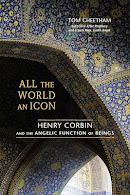"...the Imagination (or love, or sympathy, or any other sentiment) induces knowledge, and knowledge of an 'object' which is proper to it..."
Henry Corbin (1903-1978) was a scholar, philosopher and theologian. He was a champion of the transformative power of the Imagination and of the transcendent reality of the individual in a world threatened by totalitarianisms of all kinds. One of the 20th century’s most prolific scholars of Islamic mysticism, Corbin was Professor of Islam & Islamic Philosophy at the Sorbonne in Paris and at the University of Teheran. He was a major figure at the Eranos Conferences in Switzerland. He introduced the concept of the mundus imaginalis into contemporary thought. His work has provided a foundation for archetypal psychology as developed by James Hillman and influenced countless poets and artists worldwide. But Corbin’s central project was to provide a framework for understanding the unity of the religions of the Book: Judaism, Christianity and Islam. His great work Alone with the Alone: Creative Imagination in the Sufism of Ibn ‘Arabi is a classic initiatory text of visionary spirituality that transcends the tragic divisions among the three great monotheisms. Corbin’s life was devoted to the struggle to free the religious imagination from fundamentalisms of every kind. His work marks a watershed in our understanding of the religions of the West and makes a profound contribution to the study of the place of the imagination in human life.Search The Legacy of Henry Corbin: Over 800 Posts
Saturday, October 20, 2012
Announcing the New Official Henry Corbin Website
It is with very great pleasure and excitement that I announce the appearance of the magnificent new website
of Les Amis de Henry et Stella Corbin:
The entire community of those interested in the life and work of Corbin should give thanks to Daniel Proulx for the enormous labor that this site represents. It is instantly the premier Corbin website on the internet and the primary place to go for news and documents concerning Corbin. There is a stunning wealth of material available including links to online texts by and about Corbin, photographs, news and more. And M. Proulx promises more to come in the near future including selections from the vast treasure of documents in the Corbin Achive in Paris. It is long past time for this wonderful resource to become available to the world-wide community of "Corbinistes." It is worth spending quite a long time exploring.
Monday, October 15, 2012
Mundus imaginalis in Buenos Aires
Literatura | Programación actual
| |||||||||
|
Monday, October 8, 2012
8e Journée Henry Corbin « Qu’est-ce que la mystique ? »
8e Journée Henry Corbin
« Qu’est-ce que la mystique ? »
le samedi 1 décembre 2012
à l’Ecole Normale Supérieure, 45 rue d’Ulm, 75005 Paris, salle Dusanne
Matinée
9h 30 : Leili ANVAR-CHENDEROFF (INALCO) : « La mystique peut-elle se dire? Le cas de Farid od-dîn 'Attâr »
10 h 30 : Daniela BOCCASSINI (Université de Vancouver) : « De la «Vita Nova» à la «Vista Nova»: le parcours mystique de Dante »
11 h 30 : Daniel DE SMET (CNRS) : « Y a-t-il une mystique ismaélienne ? »
Après-midi
Après-midi
14 h 30 – 17 h : Table ronde sur le thème « Qu’est-ce que la mystique chez Henry Corbin ? », avec Christian JAMBET (EPHE), Daniel PROULX (Université de Louvain), Pierre LORY (EPHE), suivie d’un échange avec le public.
Friday, October 5, 2012
Powerful Women: Painting and Building in Persianate Culture
Sussan Babaie, Professor of Persian Art and Architecture, The Courtauld Institute of Art, University of London
Women courting princes, visiting mausoleums, bathing and dancing at court, hunting— Persianate book painting of the fifteenth century is extraordinarily rich in images of women. Equally impressive are extant examples of monumental patronage by women of the House of Timur. Explore the implications for patronage in this period of the "female touch." This program is made possible by the American Institute of Iranian Studies.
Subscribe to:
Posts (Atom)





